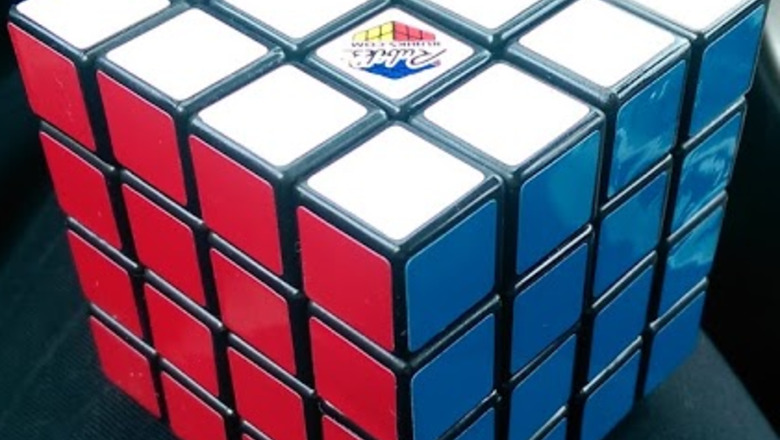
views
Getting Started
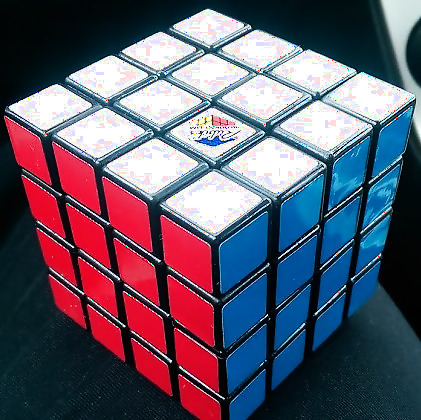
Familiarize yourself with the Rubik's Cube. Recognize where each of the colors lie on the completed cube. Notice (going clockwise) the Red, White, and Blue faces of the cube are on one side and the Green, Orange, and Yellow faces are on another. This is the standard setup for newer, standard cubes. If your cube is older or is from another manufacturer than Rubik' Cube® itself, the setup might be different and you'll have to take a look at a solved version of your Rubik's Cube on the manufacturer's website. There are four similar center pieces on each face of the cube, four unique corner pieces, and 8 pairs of edge pieces (every two between corners are identical).
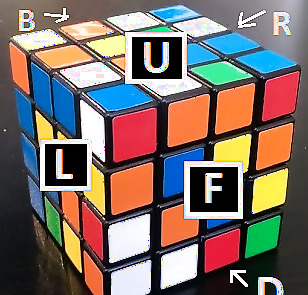
Learn some notation so certain parts of this article are clear. Each face of the cube has a different letter to show which way you need to face it. F = Front B = Back U = Up D = Down L = Left R = Right In an algorithm, each of these next letters in the diagram will represent a different row or column of the cube and by itself it will mean to turn that row or column once clockwise, an apostrophe ( ' ) will note to turn that row or column of the cube counter-clockwise once and a 2 ( 2 ) will note to turn the cube clockwise twice. Capital letters denote an outer layer of the cube while lower-case letters are the inner layers. Scrampled 2.PNG An example algorithm could be something like F u' r L2 u. This particular algorithm if spoken would sound like: Turn the outside front layer clockwise once, the inside up layer counter-clockwise once, the inside right layer clockwise once, the outside left layer clockwise twice, and the inside up layer clockwise once.
Scramble your Rubik's Cube. Assuming your Rubik's Cube is brand new, you will need to take it out of the box and scramble it. There is not really a wrong way to do this, but you should spend about 60 seconds to do so.
Solving the Cube
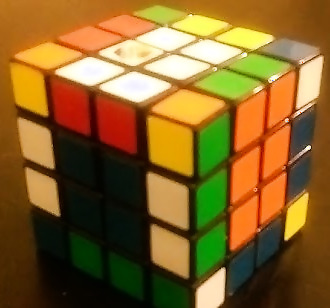
Start with the 2x2 centers on each face of the cube. We are going to begin with one side of the cube in this step. You will need to solve three faces on one side of the cube consecutively before being able to solve the opposite side, so refer to the cube layout as explained earlier, and choose either the Red, White, and Blue or the Orange, Yellow, and Green. Begin with the White center and keep in mind where the Red and Blue centers will need to be in relation to it. Now solve the Red center being mindful to not scramble the white center. Then, the blue center. RWB centers.PNG Dan Harris Dan Harris, Rubik's Cube World Record Holder & Speedcubing Expert The key to solving a 4x4x4 Rubik's Cube is to first form the center pieces of each face, pair up edge pieces of the same colors, and finally solve the outer layers as you would a 3x3 cube using commutators, conjugates or other speedcubing methods. With practice, you can solve a Revenge cube under a minute.
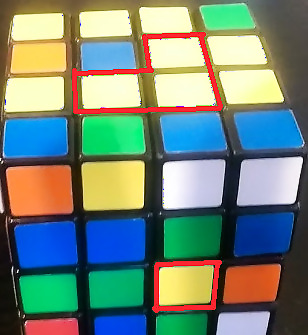
Solve the opposite side of the cube. For the opposite side of the cube, the solution is a bit trickier and requires more direction. The object here is to find an “L-shaped” center. As you can see, to solve one of these, you must temporarily move one of the other solved centers. To start, put the corner of the L-shape in the lower right corner of the center. Find the last matching color on the other side of the cube and turn it to the lower right corner as well. Now follow this algorithm to complete the center: r U r' Repeat this process for the remaining two centers and they should turn out the same. Yellow L shape edit.png
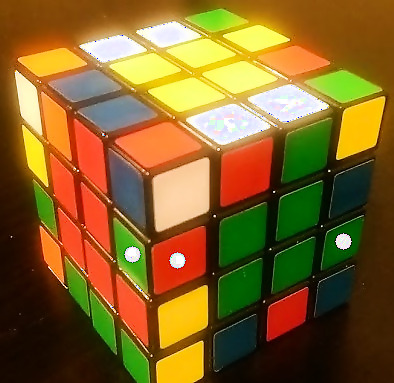
Complete each of the edge pairings. There are exactly two of each edge piece and they will fit right next to each other between two corners. Begin by finding two of the same edge pieces. Here you will see a Red/Green pairing. Situate these two edge pieces on the same face of the cube, on opposite ends of the face, and showing opposite colors. In the next two pictures, the edge pair is highlighted with a white dot on each face. Edge pairing start edit.png Using the Green center as the Front of the cube, follow this algorithm to complete the edge pairing: U u R U' R' U' u' Edge pairing finish edit.png Repeat this process with other pairs until there are two unmatched pairs left.
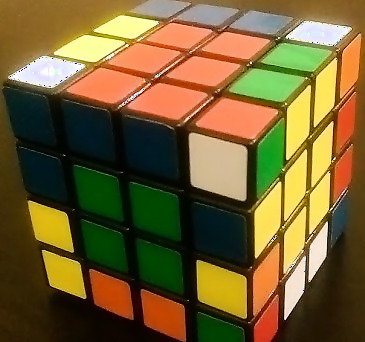
Solve for the “edge parity” of the last two pairs that need to be put together on the cube. Because the original edge pairing algorithm will not work, you must use a new algorithm for this step. Begin by turning each color of each pair to match, but put them directly across from each other on the same face. In this picture, you'll see this with the Blue and Yellow squares to the opposite sides of the Green center. Edge parity.PNG Now you will need to perform this algorithm: D d R F' U R' F D' d'. Your cube should now have all the edges and centers solved.
Using 3x3x3 Strategy
Use a 3x3x3 Rubik's Cube strategy to solve. If you are at all familiar with a standard 3x3x3 Rubik's Cube, you may notice that is exactly what the cube resembles at this point. The 4 center pieces on each face represent a single center piece. Each pair of 2 adjacent edge pieces represent a single edge piece. The corners are all the same as the 3x3x3 cube.
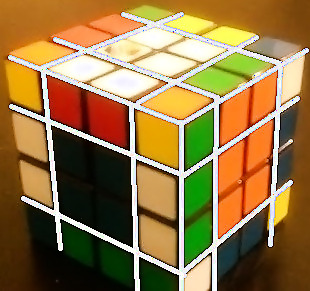
Solve for a White "cross" section to start. White cross.PNG From here, you will need to add the corners, so find a white corner piece and move it into a position to be joining the White face. Be mindful of the other colors on the corner piece, and be sure they correspond to the other sides once in place. In the picture above you can see three white corner pieces off of the main white face. You cannot force these corners into the white side without disturbing the White cross, so when they are in this exact position, use this algorithm: B' U' B U. Repeat this process three more times until you have an entirely White face of the cube complete.
Solve entire center layer of the cube. You should notice at this point you will have four “T-shaped” patterns surrounding the White face.
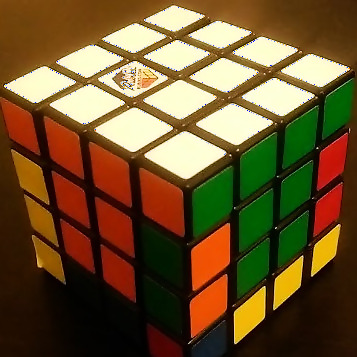
Turn the cube around so the white face is facing away from you. Pick a color around the yellow center that is not yellow, and turn the cube so that color is on the side of the cube with the center that it matches. This will make a larger “T-shape”. Large t shape.PNG You will notice that the Green/Red edge pair needs to be moved to the front face in the picture above. In order to do this, follow this algorithm: F' D' R' T D R. After putting this in place, you will need to go back and resolve part of the White face using the strategies in the 3x3x3 approach. After repeating this about four times, you will have solved the top three layers of the cube. 3 layers.PNG
Solve for a Yellow cross-shape. At this point when you turn your cube to the Yellow face you will see one of three possible patterns: an “L-shape”, a “Bar” shape (yellow blocks in a straight line), or just the yellow center. For the L-shape, use this algorithm: F U R U' R' F' For the Bar shape, use this algorithm: F R U R' U' F' If you have just the yellow center, then choose either of the processes and do it twice.
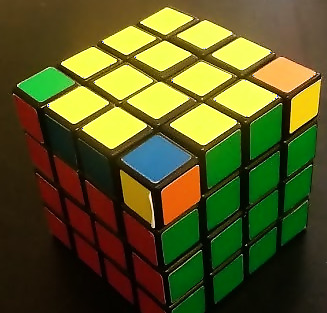
Solve for the Yellow corners. You will now have a Yellow cross on the face of the cube and you may have one or more Yellow corners as well. This step is to solve for the rest. Find one yellow corner not on the yellow face cube and turn it toward you. Follow this algorithm: R U R' U R U2 R'. Repeat this until the Yellow face is complete.
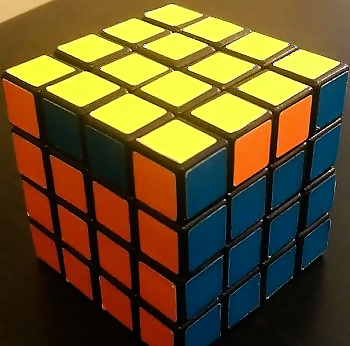
Solve for the last layer. If you have any two corners on the same side matching, turn them to their matching side, and turn that face of the cube away from you for this next part. If you had no matching corners, repeat this step twice. Follow this algorithm: R' F R' B2 R F' R' B2 R2 Final step.PNG Now, sometimes every side will be solved. However, once in a while, you may get a seemingly unsolvable case, called a parity. Now there are two cases you might run into. First, if the two sides are opposite each other, perform this algorithm: (Rr)2 B2 U2 (Ll) U2 (Rr)' U2 (Rr) U2 F2 (Rr) F2 (Ll)' B2 (Rr)2. If the two sides are adjacent to each other, first perform this algorithm: R U R'U', then perform the above algorithm, and finally, perform this algorithm: U R U' R' Your 4x4x4 Rubik's Cube is now solved!




















Comments
0 comment